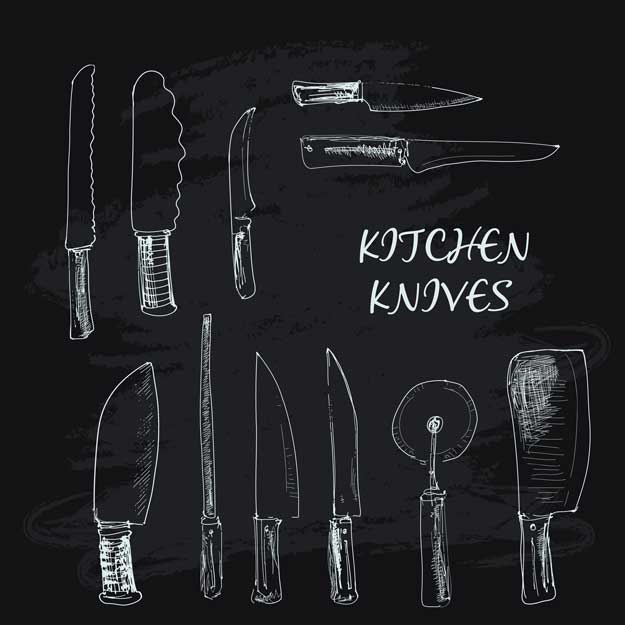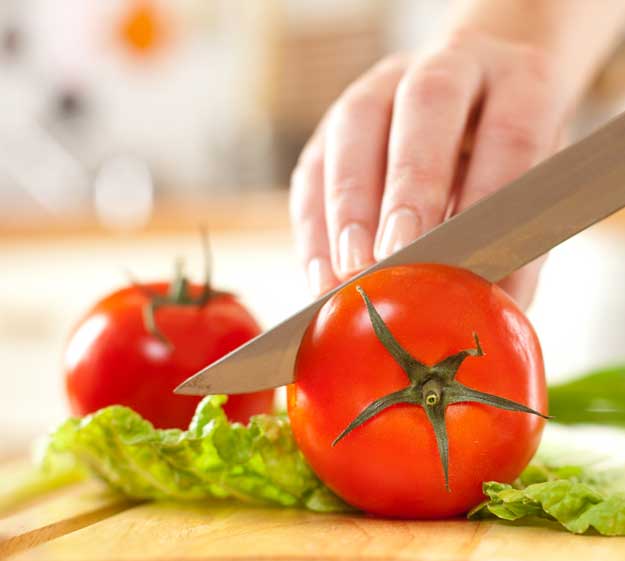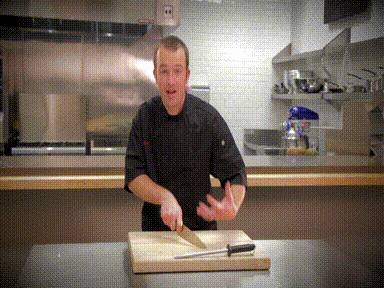Welcome to our Intro to Knife Skills Course where we’ll go over the knives you should have in your kitchen, the types of cuts you can make, and safe knife handling tips to help you cut, chop and dice like the pros in no time!

image via
When we first became serious about cooking, the first thing we knew we had to learn was how to properly handle a knife. We were definitely guilty of holding the knife at the edge of the handle with our fingers splayed out, begging for a serious injury to occur. And while learning how to properly hold a knife was foreign at first, with time and practice, we found ourselves asking to prep every- and anything! While we’re no Gordon Ramsay (one day!), we definitely pride ourselves on how far we’ve come.
Most frequently used knives…and then some

The four knives every cook should have in their kitchen are: chef knife, serrated utility knife, paring knife and boning knife.
These knives are ranked in order of importance with the chef knife taking the lead as it will be the one you use most frequently for just about everything. The more comfortable you become with your knife, the more you’ll start to realize just how incredibly important it is (we’re definitely not ashamed to say that we love our chef knife as it the tool that makes our dreams and passions possible). Your chef knife will become your new best friend and that’s not a bad thing!
Chef Knives
Chef knives are multi-functional and can be used for everything from chopping and slicing fruits and veggies to cutting meat. Chef knives are usually between 6 – 14 inches and have a broad blade that curves upwards to make fine mincing easier. Longer blades can make faster cuts, but are more difficult to control, while shorter blades allow for greater control, but are generally used by chefs with small hands.
Serrated Utility Knives
The serrated utility knife is perfect for making small, clean, non-tearing cuts on delicious food items such as fruit, veggies, and even bagels. The serrated utility knife is smaller (4-7 inches) and extremely sharp
Paring Knives
The paring knife is a tiny little guy with a blade that measures out to be 2 ½ – 4 inches in length. This knife is ideal for intricate cuts such as peeling, deveining, or creating garnishes and decorations. In general, paring knives can be used for basic kitchen utility work.
Boning Knives
Boning knives are ideal for removing meat from bones and cutting fish or poultry. Their small size makes them the perfect tool for getting those precise cuts.
Other knives that aren’t so commonly used, but can definitely be handy to have around, are bread knives, carving knives, cleavers, mincing knives, peeling knives, and trimming knives.
How to choose your knives (or does the knife choose you?)
Unfortunately, there is no simple formula for choosing your knives. The best, most helpful tip we can provide (and one that is often overlooked) is whichever brand or style knife you choose has to feel good in your hands. Remember, these are your greatest allies in the kitchen and you want to feel like you can trust them with everything, even your life!
Four things to remember when shopping for knives are:
- Go for quality over quantity. For most recipes, all you really need is a high-quality chef’s knife. Because knives are used so frequently, a lower-quality knife will mean frequent repurchasing.
- Find out what your knives are made of. The sharpest, longest-lasting materials for knives are SG-2 or VG-10 steel.
- Make sure your knives come with a knife block! Or buy one. Knives stored in a cutlery drawer will dull quicker than knives stored in a knife block.
- Do you want stamped or forged knives? Forged knives are hand-carved using heat to form the blade; they are also heavier, more durable, longer-lasting and stay sharper longer than their stamped counterparts.
When shopping for knives, go to a place that allows you to try out multiple blades and brands. Only then can you get a feel for what knife suits you best.
Types of Knife Cuts

There are tons of knife cuts out there and while all of them are exciting to know, the four main cuts you’ll be working with are:
Slicing
The Slice is the most commonly-used cut in the kitchen and the first one to know when embarking on your cooking journey. Use this cut for large vegetables and meats or whenever you want to rough-slice herbs. To see this cut in action, refer to this video by Serious Eats: The Slice.
Chopping
The Chop is similar to the Slice (aren’t these names great?), but differs in that this cut can be used to create precise cuts when working with vegetables or herbs.
Back-Slicing
This cut is used to create thin, elegant slices of small, fragile items. This cut ensures that the produce or ingredients you are working with aren’t crushed or bruised. Check out the Back-Slice in action here.
Rock-Chopping
This cut (which is, in our opinion, the most fun to employ) is used for fine mincing. When using this cut, make sure the cutting board you are working with is stable and in even contact with your countertop. You don’t want to end up mincing something else! To see this cut in action, refer to this video by Serious Eats: The Rock-Chop.
If you’re new to cooking, these are going to be the four cuts you need to learn before getting fancy with Julienne, Chiffonade or Rondelle cuts. If you’re already a pro, think of this as a refresher and check out this post by The Culinary Cook on advanced knife cuts.
Knife Handling Tips

Below are some refresher tips to keep in mind when working with knives:
- Keep your knife sharp! Like, so sharp the smallest amount of pressure will create a thin, clean cut. To test the sharpness of your knife, cut into a tomato. A sharp knife will produce a clean cut without any tears.
- Channel the power of “The Claw” to keep your holding hand safe. At first, “The Claw” will feel weird (we initially spent days looking for alternate versions of “The Claw” until we chopped our nail off and realized how important “The Claw” really was), but whenever you start to give up on it, just remember that “The Claw” is important for a reason as it protects your fingers from getting dismembered.
- To make a claw, curl your fingers inward and rest the tips on top of the item you’re cutting. Tuck your thumb in and keep this formation as you cut. An indicator that you’re doing it right is when the blade is parallel to your knuckles.
- Stabilize your cutting board with a damp kitchen towel. A slippery cutting board can very well lead to a slippery knife!
- This one is common sense and is really here as an added precaution, but never keep knives close to any edge. And if they are close to an edge and happen to fall, don’t try to catch them! (It’s instinctual to want to catch a falling item, but fight nature and resist the urge!)
- When cooking with someone else, always make sure they know where the knife you are using is at any given moment. In every restaurant, cafe or bakery kitchen, you’ll always hear employees yelling, “Behind, knife!” to avoid impaling one of their co-workers.
If you’re just starting to get serious in the kitchen, knife skills are paramount to your growth and success as a home chef. We hope this Intro to Knife Skills Course provided some useful information and please use this as a resource and guide to refer back to as your skills grow and evolve. Home cooking is not only satisfying, but life-affirming, creative, and, in practical terms, cost-effective. While there are many skills to learn, knife skills are, hands down, the most important to know.
To supplement the above information, we’ve included links to great videos on basic knife skills and cuts! The perfect tool for all of you visual learners out there, these videos are sure to make you want to run to the kitchen, stabilize your cutting board, and practice with your own set of knives. Enjoy!
That’s all, folks! If you enjoyed our Intro to Knife Skills post, let us know in the Comments section below. We love hearing your feedback and comments; we also love sharing recipes, so if you have a recipe, or skill, you’d like to share, we’d love to read and try it out for ourselves! HomemadeRecipes.com was founded to create an online community where foodies, epicureans and chefs can share recipes and learn new ones! If you love to cook, love food or have some great recipes and ideas you’d like to share with us, shoot us an email and make sure to stay in touch on Facebook, Twitter, and Pinterest! We’re always looking for contributors and want to hear from you.
Do you have Instagram? Don’t forget to follow @HomemadeRecipesOfficial.
Click here to Like Us on Facebook.
Click here to Follow Homemade Recipes on Pinterest
Leave a Reply